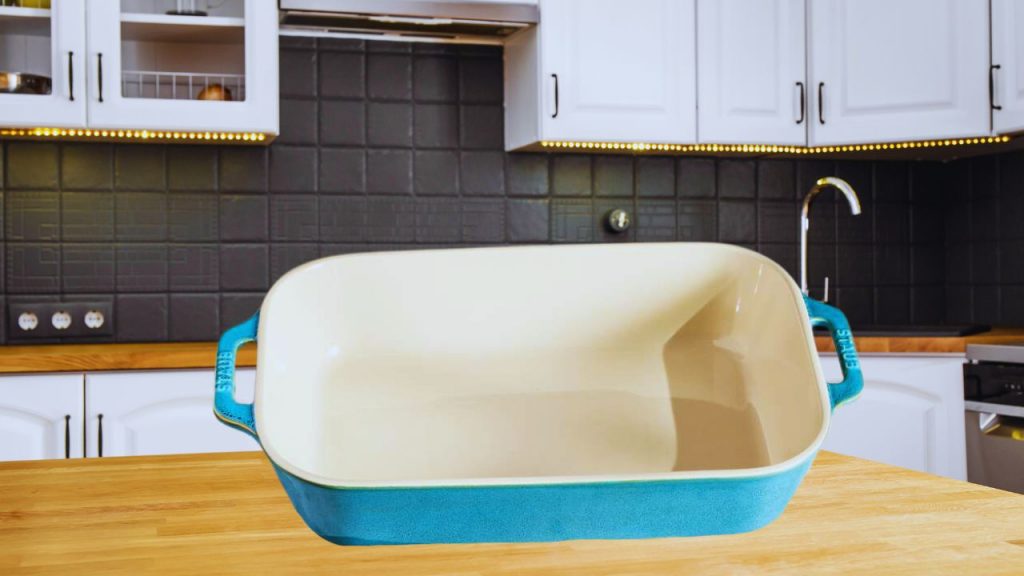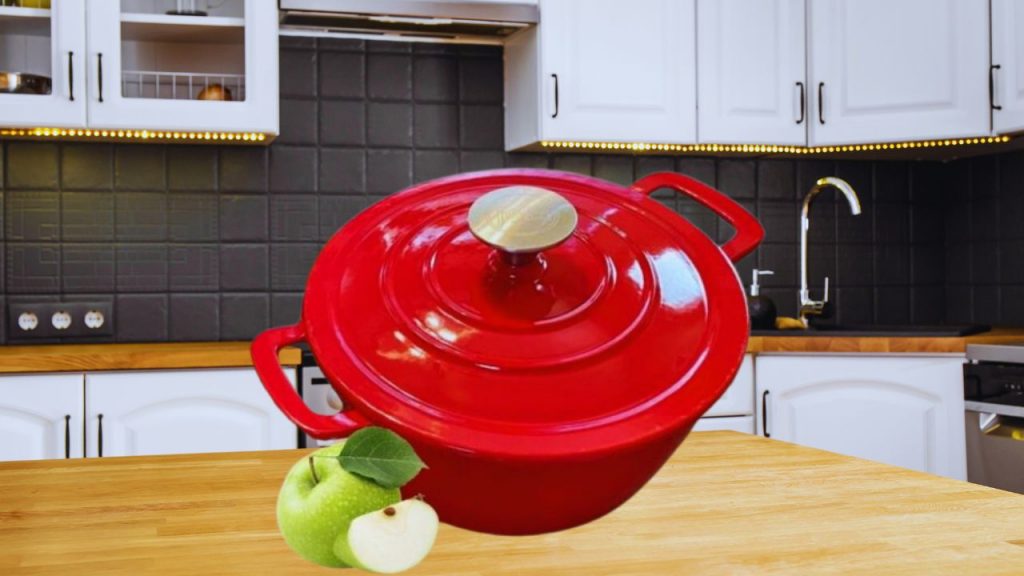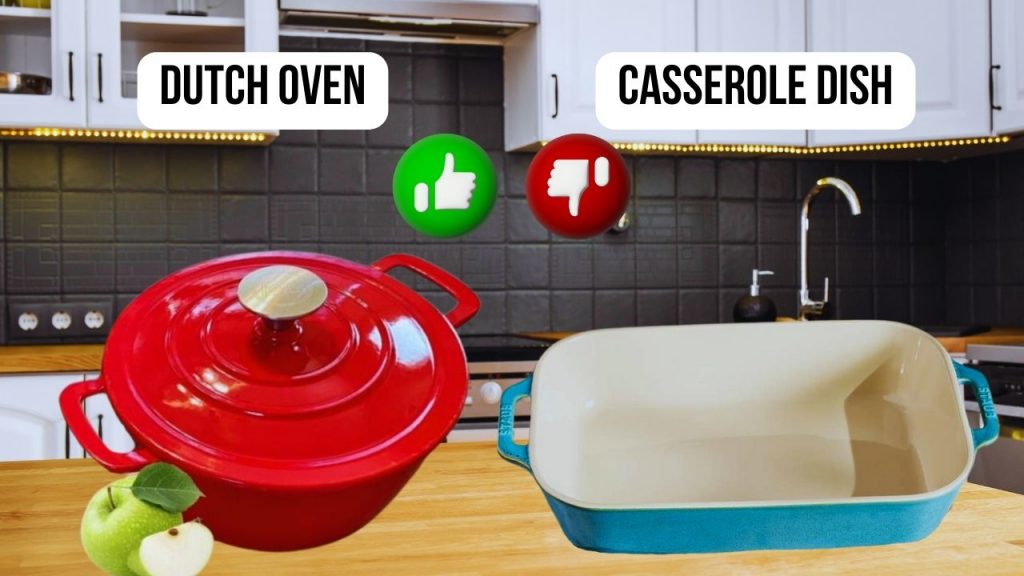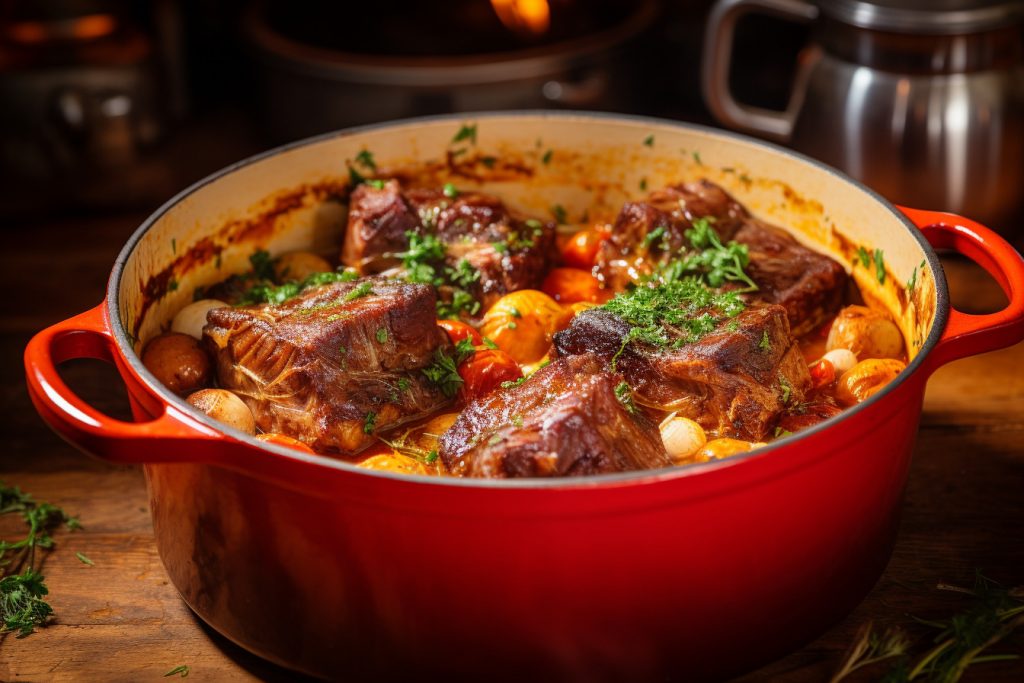Some people are confused about two essential kitchen tools: the casserole dish and the Dutch oven. Both of these are large pots that help us cook various foods like pasta, baked dishes, and stews. People often mix up their names, thinking they’re the same. However, they are actually two different things.
As a seasoned restaurant chef with a decade of experience, I will explain what makes them distinct, even though they might look similar.
What is a Casserole Dish?

A Casserole dish is a shallow, ovenproof container designed for baking and serving one-pot meals, typically made of glass, ceramic, or even metal. Its low sides and wide, flat bottom provide an ideal surface for layering ingredients and achieving even cooking.
Casserole dishes often come with a tightly fitting lid, which helps to trap moisture and flavors during cooking. Their materials make them an excellent choice for dishes that benefit from slow, even heat distribution. They come in various sizes and shapes, allowing for versatility in the kitchen.
What is a Dutch Oven?

Dutch ovens are popular cookware. They are heavy, thick-walled cooking pots, typically made of cast iron but also available in enamel-coated varieties. They feature high, straight sides and a snug-fitting lid designed for slow cooking, simmering, and braising. Dutch ovens are also known for their ability to distribute heat evenly.
Dutch Ovens are known for their remarkable heat retention, which makes them perfect for long, slow-cooking recipes. The heavy lid often has a knob or handle that can withstand high temperatures. They can also be used to cook food on a stovetop or in the oven. Enamel-coated Dutch Ovens come in many colors and are easier to clean.
Similarities Between Casserole Dish and Dutch Oven
Both casserole dishes and Dutch ovens share some notable features. Hence, people often interchange these two. Here are some of their similarities:
- Versatility: Both are incredibly versatile and can be used for various cooking methods, from baking and braising to frying and simmering.
- Oven-Safe: They can withstand high temperatures and are suitable for stovetop and oven use.
- Tight-Fitting Lids: Both come with lids that help trap moisture and flavors.
- Even Heat Distribution: Their designs and materials promote even heat distribution, ensuring that food cooks uniformly.
- Aesthetics: Casserole dishes and Dutch ovens are aesthetically pleasing and can go directly from the oven to the dining table.

Difference Between Casserole Dish and Dutch Oven
Now, let’s take a closer look at these two cookware to find out their unique attributes. Here are some key differences between a casserole dish and a Dutch oven.
- Material: Casserole Dishes are typically made of glass or ceramic, while Dutch Ovens are predominantly cast iron or enamel-coated cast iron. The material choice affects their heat retention and weight.
- Depth: Casserole dishes have shallower sides, while Dutch ovens feature high, straight sides. The depth impacts the types of dishes they’re best suited for.
- Weight: Dutch ovens are substantially heavier due to their cast iron construction, which contributes to their excellent heat retention but may pose challenges for some users.
- Price: Dutch ovens are usually more expensive than casserole dishes, primarily due to their cast iron or enamel coatings.
- Maintenance: Enamel-coated Dutch Ovens are easier to clean and require less maintenance than traditional cast iron Dutch Ovens. Casserole Dishes are relatively low-maintenance.
Can I Use a Casserole Dish as a Substitute For a Dutch Oven?
Now that we’ve explored the differences between casserole dishes and Dutch ovens, you might wonder if you can use a casserole dish instead of a Dutch oven. The answer largely depends on what you’re cooking and the heat requirements of your recipe.
The good news is that you can often use a casserole dish for most recipes meant for a Dutch oven. The key is to consider the heat requirements of your recipe. If the recipe specifically requires a Dutch oven‘s high heat retention properties, such as baking bread or slow-braising meat, using a casserole dish might not yield the same results.
So, before attempting the substitution, always check the heat requirements in the recipe. If it doesn’t call for the exceptional heat-retention qualities of a Dutch oven, feel free to use your trusty casserole dish instead. It’s all about adapting and improvising in the kitchen, making the most of the tools you have at your disposal.
Which One Should I Buy?

Both the casserole dish and the Dutch oven are undeniably valuable additions to any kitchen. They each bring their unique strengths and versatility, making them essential tools for various cooking tasks. However, deciding which one to buy ultimately depends on your cooking needs and preferences.
If you frequently prepare casseroles, lasagnas, and baked dishes and enjoy the convenience of cooking and serving in the same dish, a casserole dish is an excellent choice. They often come in various sizes and attractive designs, making them perfect for everyday and special occasion cooking. The relatively lighter weight of casserole dishes can also be a bonus if you’re looking for a versatile, easy-to-handle option in the kitchen.
On the other hand, a Dutch oven is the best choice if you like cooking slow-cooked stews, braised meats, hearty soups, and artisanal bread baking. Dutch ovens’ exceptional heat retention properties, particularly those made of cast iron, are well-suited for these culinary endeavors. Their ability to create succulent, tender, and flavorful dishes through long, low-temperature cooking is unmatched.
What To Do If You Don’t Have a Dutch Oven or Casserole Dish?
In such scenarios, a cast iron skillet emerges as a hero in the kitchen. A cast iron skillet can replicate Dutch ovens’ slow and even heat thanks to its heavy bottom. I’ve found success using a cast iron skillet by sealing the top with tin foil, effectively trapping all the moisture within the pan and mimicking the environment of a Dutch oven.
While it’s a commendable substitute, it’s essential to note that cast iron skillets have a downside—they’re notably smaller than Dutch ovens. Thus, you might have to adjust your recipe quantities to fit the confines of the skillet, potentially halving your usual batch.
If you find yourself without a casserole dish or a Dutch oven and the skillet isn’t the right fit, consider turning to other kitchen devices. Slow cookers, air fryers, and Instant Pots can also help you achieve the desired slow-cooked, flavorful results.
Conclusion
Both Casserole Dishes and Dutch Ovens are indispensable tools in the kitchen. However, they serve slightly different purposes, primarily due to their design and material construction. While the choice between the two may ultimately come down to personal preference and cooking style, I find myself reaching for both regularly in my restaurant and home kitchen.
Casserole Dishes are perfect for casseroles, lasagnas, and other layered dishes, while Dutch Ovens excel at slow-cooked stews, braised meats, and soups. So, if you’re a culinary enthusiast or a professional chef like myself, having both these cookware options at your disposal is the key to culinary success.
Check out the top Dutch oven options for this year.

